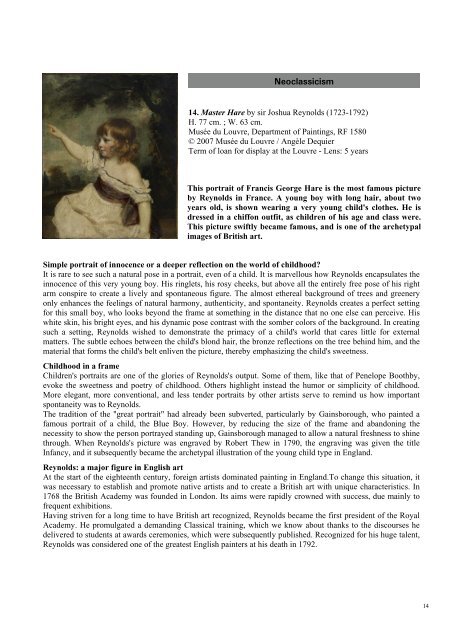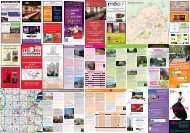The Galerie du Temps at the Louvre-Lens A unique presentation of ...
The Galerie du Temps at the Louvre-Lens A unique presentation of ...
The Galerie du Temps at the Louvre-Lens A unique presentation of ...
You also want an ePaper? Increase the reach of your titles
YUMPU automatically turns print PDFs into web optimized ePapers that Google loves.
Neoclassicism<br />
14. Master Hare by sir Joshua Reynolds (1723-1792)<br />
H. 77 cm. ; W. 63 cm.<br />
Musée <strong>du</strong> <strong>Louvre</strong>, Department <strong>of</strong> Paintings, RF 1580<br />
© 2007 Musée <strong>du</strong> <strong>Louvre</strong> / Angèle Dequier<br />
Term <strong>of</strong> loan for display <strong>at</strong> <strong>the</strong> <strong>Louvre</strong> - <strong>Lens</strong>: 5 years<br />
This portrait <strong>of</strong> Francis George Hare is <strong>the</strong> most famous picture<br />
by Reynolds in France. A young boy with long hair, about two<br />
years old, is shown wearing a very young child's clo<strong>the</strong>s. He is<br />
dressed in a chiffon outfit, as children <strong>of</strong> his age and class were.<br />
This picture swiftly became famous, and is one <strong>of</strong> <strong>the</strong> archetypal<br />
images <strong>of</strong> British art.<br />
Simple portrait <strong>of</strong> innocence or a deeper reflection on <strong>the</strong> world <strong>of</strong> childhood?<br />
It is rare to see such a n<strong>at</strong>ural pose in a portrait, even <strong>of</strong> a child. It is marvellous how Reynolds encapsul<strong>at</strong>es <strong>the</strong><br />
innocence <strong>of</strong> this very young boy. His ringlets, his rosy cheeks, but above all <strong>the</strong> entirely free pose <strong>of</strong> his right<br />
arm conspire to cre<strong>at</strong>e a lively and spontaneous figure. <strong>The</strong> almost e<strong>the</strong>real background <strong>of</strong> trees and greenery<br />
only enhances <strong>the</strong> feelings <strong>of</strong> n<strong>at</strong>ural harmony, au<strong>the</strong>nticity, and spontaneity. Reynolds cre<strong>at</strong>es a perfect setting<br />
for this small boy, who looks beyond <strong>the</strong> frame <strong>at</strong> something in <strong>the</strong> distance th<strong>at</strong> no one else can perceive. His<br />
white skin, his bright eyes, and his dynamic pose contrast with <strong>the</strong> somber colors <strong>of</strong> <strong>the</strong> background. In cre<strong>at</strong>ing<br />
such a setting, Reynolds wished to demonstr<strong>at</strong>e <strong>the</strong> primacy <strong>of</strong> a child's world th<strong>at</strong> cares little for external<br />
m<strong>at</strong>ters. <strong>The</strong> subtle echoes between <strong>the</strong> child's blond hair, <strong>the</strong> bronze reflections on <strong>the</strong> tree behind him, and <strong>the</strong><br />
m<strong>at</strong>erial th<strong>at</strong> forms <strong>the</strong> child's belt enliven <strong>the</strong> picture, <strong>the</strong>reby emphasizing <strong>the</strong> child's sweetness.<br />
Childhood in a frame<br />
Children's portraits are one <strong>of</strong> <strong>the</strong> glories <strong>of</strong> Reynolds's output. Some <strong>of</strong> <strong>the</strong>m, like th<strong>at</strong> <strong>of</strong> Penelope Boothby,<br />
evoke <strong>the</strong> sweetness and poetry <strong>of</strong> childhood. O<strong>the</strong>rs highlight instead <strong>the</strong> humor or simplicity <strong>of</strong> childhood.<br />
More elegant, more conventional, and less tender portraits by o<strong>the</strong>r artists serve to remind us how important<br />
spontaneity was to Reynolds.<br />
<strong>The</strong> tradition <strong>of</strong> <strong>the</strong> "gre<strong>at</strong> portrait" had already been subverted, particularly by Gainsborough, who painted a<br />
famous portrait <strong>of</strong> a child, <strong>the</strong> Blue Boy. However, by re<strong>du</strong>cing <strong>the</strong> size <strong>of</strong> <strong>the</strong> frame and abandoning <strong>the</strong><br />
necessity to show <strong>the</strong> person portrayed standing up, Gainsborough managed to allow a n<strong>at</strong>ural freshness to shine<br />
through. When Reynolds's picture was engraved by Robert <strong>The</strong>w in 1790, <strong>the</strong> engraving was given <strong>the</strong> title<br />
Infancy, and it subsequently became <strong>the</strong> archetypal illustr<strong>at</strong>ion <strong>of</strong> <strong>the</strong> young child type in England.<br />
Reynolds: a major figure in English art<br />
At <strong>the</strong> start <strong>of</strong> <strong>the</strong> eighteenth century, foreign artists domin<strong>at</strong>ed painting in England.To change this situ<strong>at</strong>ion, it<br />
was necessary to establish and promote n<strong>at</strong>ive artists and to cre<strong>at</strong>e a British art with <strong>unique</strong> characteristics. In<br />
1768 <strong>the</strong> British Academy was founded in London. Its aims were rapidly crowned with success, <strong>du</strong>e mainly to<br />
frequent exhibitions.<br />
Having striven for a long time to have British art recognized, Reynolds became <strong>the</strong> first president <strong>of</strong> <strong>the</strong> Royal<br />
Academy. He promulg<strong>at</strong>ed a demanding Classical training, which we know about thanks to <strong>the</strong> discourses he<br />
delivered to students <strong>at</strong> awards ceremonies, which were subsequently published. Recognized for his huge talent,<br />
Reynolds was considered one <strong>of</strong> <strong>the</strong> gre<strong>at</strong>est English painters <strong>at</strong> his de<strong>at</strong>h in 1792.<br />
14



